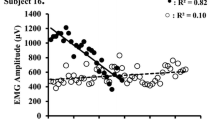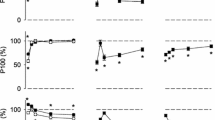Summary
The aim of the study was to investigate the recovery of the maxium voluntary contraction force (MVC), the endurance time and electromyographical (EMG) parameters following exhaustive dynamic exercise of the m. biceps brachii. EMG recordings were made in ten healthy subjects using bipolar surface electrodes placed over the common belly of the left arm biceps muscle. Up to 25 h post-exercise, the maximum contraction force and the EMG signal were recorded alternately at regular intervals. The EMG signal was recorded during 30-s contractions at 40% of the pre-fatigued MVC. Four hours and 25 h post-exercise, the endurance time of a 40% pre-fatigued MVC was recorded. Up to 25 h after the exercise the maximum contraction force, the endurance time and the EMG parameters were significantly different from the pre-exercise values. Nine out of ten subjects complained that muscle soreness had developed. Thus, long-lasting changes are found after exhaustive dynamic exercise, not only in the MVC and the muscle's endurance capacity, but also in the EMG signal.
Similar content being viewed by others
References
Abraham WM (1977) Factors in delayed muscle soreness. Med Sci Sports 9:11–20
Bigland-Ritchie B (1981) EMG/Force relations and fatigue of human voluntary contractions. Exerc Sport Sci Rev 9:75–117
Bobbert MF, Hollander AP, Huijing PA (1986) Factors in delayed onset muscle soreness of man. Med Sci Sports Excerc 18:75–81
Christensen H (1986) Muscle activity and fatigue in the shoulder muscles during repetitive work, an electromyographic study. Eur J Appl Physiol 54:596–601
Christensen LV (1981) Jaw muscle fatigue and pains induced by experimental tooth clenching: A review. J Oral Rehab 8:27–36
Christensen LV (1986) Physiology and pathophysiology of skeletal muscle contractions. J Oral Rehab 13:463–477
Clarke DH, Stull GA (1969) Strength recovery patterns following isometric and isotonic exercise. J Mot Behav 3:233–243
Clarkson PM, Byrnes WC, McCormick KM, Turcotte LP, White JS (1986) Muscle soreness and serum creatine kinase activity following isometric, eccentric and concentric exercise. Int J Sports Med 7:152–155
Edwards RHT (1978) Physiological analysis of skeletal muscle weakness and fatigue. Clin Sci Molec Med 54:463–470
Edwards RHT, Hill DK, Jones DA, Merton PA (1977) Fatigue of long duration in human skeletal muscle after exercise. J Physiol 272:769–778
Friden J, Sjostrom M, Ekblom B (1981) A morphological study of delayed muscle soreness. Experienta 37:506–507
Funderburk CF, Hipskind SG, Welton RC, Lind AR (1974) Development of and recovery from fatigue induced by static effort at various tensions. J Appl Physiol 37:392–396
Hagberg M, Ericson BE (1982) Myoelectric power spectrum dependence on muscular contraction level of elbow flexors. Eur J Appl Physiol 48:147–156
Hara T (1980) Evaluation of recovery from local muscle fatigue by voluntary test contractions. J Human Ergol 9:35–46
Hough T (1902) Ergographic studies on muscular soreness. Am J Physiol 7:76–81
Hultman E, Spriet LL (1986) Skeletal muscle metabolism, contraction force and glycogen utilization during prolonged electrical stimulation in humans. J Physiol 374:493–501
Jones DA, Newham DJ, Round JM, Tolfree SEJ (1986) Experimental human muscle damage: morphological changes in relation to other indices of damage. J Physiol 375:435–448
Kahabka G (1987) Die Erholung nach muskulär ermüdender Arbeit bei ungestörtem und gestörtem Erholzeitverlauf. Z Arb Wiss 41-1:44–50
Komi PV, Buskirk ER (1970) Reproducibility of electromyographic measurements with inserted wire electrodes and surface electrodes. Electromyography 357–367
Komi P, Viitasalo JT (1977) Changes in motor unit activity and metabolism in human skeletal muscle during and after repeated eccentric and concentric contractions. Acta Physiol Scand 100:246–254
Kroon GW, Naeije M, Hansson TL (1986) Electromyographic power-spectrum changes during repeated fatiguing contractions of the human masseter muscle. Arch Oral Biol 31:603–608
Kuorinka I (1988) Restitution of EMG spectrum after muscular fatigue. Eur J Appl Physiol 57:311–315
Kwatny E, Thomas D, Kwatny HG (1970) An application of signal processing techniques to the study of myoelectric signals. IEEE Trans Biomed Engng 17:303–313
Lindström L, Kadefors R, Petersen I (1977) An electromyographic index for localized muscle fatigue. J Appl Physiol Resp Environ 43:750–754
Maton B (1981) Human motor unit activity during the onset of muscle fatigue in submaximal isometric isotonic contraction. Eur J App Physiol 46:271–281
Mills KR (1982) Power spectral analysis of electromyogram and compound muscle action potential during muscle fatigue and recovery. J Physiol 326:401–409
Mills KR, Edwards RHT (1984) Muscle fatigue in myophos. phorylase deficiency: power spectra analysis ot the electromyogram. Electroencephalogr Clin Neurophysiol 57:330–335
Naeije M, Zorn H (1981) Changes in the power spectrum of the surface electromyogram of the masseter muscle due to local muscular fatigue. Arch Oral Biol 26:409–412
Newham DJ, Jones DA, Edwards RHT (1983) Large delayed plasma creatine kinase changes after stepping exercise. Muscle Nerve 6:380–385
Petrofsky JS, Lind AR (1980) Frequency analysis of the surface electromyogram during sustained isometric contractions. Eur J Appl Physiol 43:173–182
Petrofsky JS, Glaser RM, Phillips CA (1982) Evaluation of the amplitude and frequency components of the surface EMG as an index of muscle fatigue. Ergonomics 25:213–223
Sargeant AJ, Dolan P (1987) Human muscle function following prolonged eccentric exercise. Eur J Appl Physiol 56:704–711
Stull GA (1974) Recovery of muscular endurance following rhythmic or sustained activity. J Mot Behav 6:59–66
Stull GA, Kearney JT (1978) Recovery of muscular endurance following submaximal, isometric exercise. Med Sci Sports 10-2:109–112
Vøllestad NK, Sejersted OM (1988) Biochemical correlates of fatigue. Eur J Appl Physiol 57:336–347
Vries HA de (1966) Quantitative electromyographic investigation of the spasm theory of muscle pain. Am J Physic Med 45:119–134
Author information
Authors and Affiliations
Rights and permissions
About this article
Cite this article
Kroon, G.W., Naeije, M. Recovery following exhaustive dynamic exercise in the human biceps muscle. Europ. J. Appl. Physiol. 58, 228–232 (1988). https://doi.org/10.1007/BF00417254
Accepted:
Issue Date:
DOI: https://doi.org/10.1007/BF00417254




